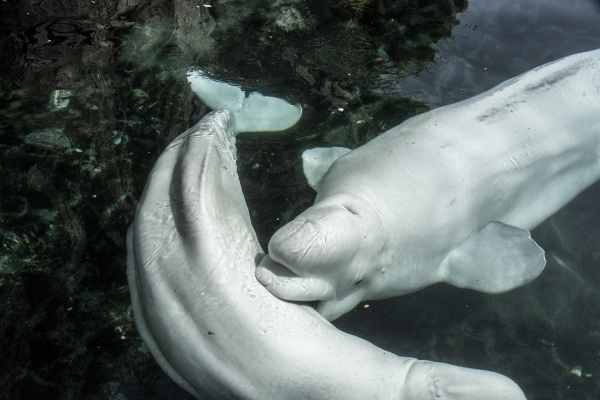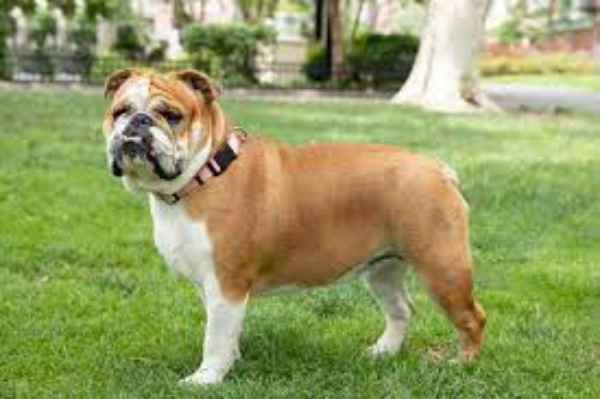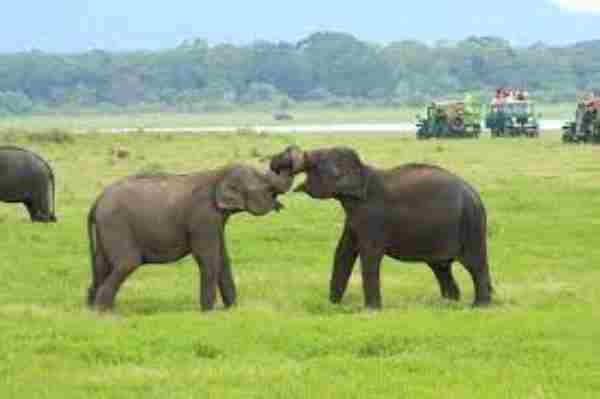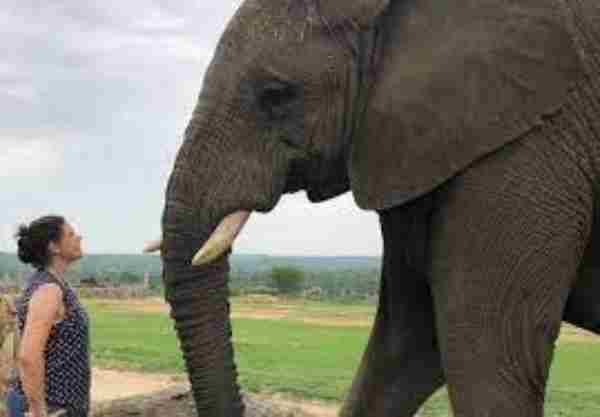Have you ever wondered if animals can have Down Syndrome? Well, the answer is yes. While humans are the primary species affected by this condition, animals can also suffer from similar cognitive disabilities. In fact, there are many animals that exhibit similar symptoms to humans with Down Syndrome.
Table of Contents
From dogs to cats to monkeys, the animal kingdom is full of unique individuals that have captured the hearts of many. So, let’s explore the top 10 animals with Down Syndrome and learn more about these fascinating creatures that share a unique connection with humans.
Navigate to your desired section below to explore the fascinating world of the top 10 animals exhibiting genetic variations resembling Down syndrome.
#1 Down Syndrome in Monkeys

- Kingdom: Animalia
- Order: Primates
- Class: Mammalia
- Phylum: Chordata
- Infraorder: Simiiformes
Kanako, born in captivity at the Kumamoto Sanctuary, exhibited several unique characteristics that set her apart from other chimpanzees. At just one-year-old, her crossed eyes and excessive drooling became apparent. By the age of seven, Kanako had developed visual impairment along with emotional anomalies and delayed tooth development. Subsequent tests revealed that Kanako possessed a third copy of chromosome 22, a condition known as trisomy 22.
These traits closely resemble Down syndrome in humans, a genetic condition caused by the presence of an extra copy of all or part of chromosome 21. A complete additional copy of chromosome 21 is commonly referred to as trisomy 21.
Individuals with Down syndrome often exhibit craniofacial dysmorphology, including a reduced skull size, flattened head, epicanthic folds, flat nasal bridge, and an open mouth. The brain is particularly affected in Down syndrome, with a smaller overall brain size, specifically a smaller cerebellum and hippocampus.
These brain abnormalities can lead to a range of cognitive impairments, such as learning and memory deficits. Trisomy 21 is, in fact, the most frequent genetic cause of intellectual disabilities.
The rest of the body can also be affected by the imbalanced dosage of an extra chromosome 21, resulting in clubbed digits, a curved pinkie finger, wide spacing between the first and second toes, and shortened stature. Individuals with Down syndrome also have an increased incidence of congenital heart disease and Hirschsprung’s disease.
#2 Kenny the Tiger

About
- Scientific name: Panthera tigris
- Lifespan: 8 – 10 years
- Speed: 49 – 65 km/h
- Conservation status: Endangered (Population decreasing)
- Order: Carnivora
- Mass: 90 – 310 kg
Kenny, the white tiger known as the ‘ugliest’ big cat, is not a result of the chromosomal transformation that causes Down syndrome in humans, but rather the outcome of generations of inbreeding. The rarity and desirability of white tigers for their unique fur have led to aggressive breeding programs that rely on inbreeding to maintain the white fur trait.
Kenny, bred by an animal dealer seeking profit, exhibited a deformed face that was falsely attributed to Down syndrome in misleading reports. His parents were siblings, and most of their offspring, apart from Kenny and a severely cross-eyed brother named Willie, were either stillborn or died shortly after birth.
The breeder claimed that Kenny’s facial deformities were due to him repeatedly smashing his face into a wall, and he didn’t euthanize the cub at birth because he found him “too cute.” However, Kenny’s genetic facial deformities were a result of inbreeding, not chromosomal changes.
White tigers are incredibly rare and their beauty makes them highly sought after by zoos and fur traders. Unfortunately, this has led to aggressive breeding practices that rely on inbreeding to produce more tigers with white fur. Due to the detrimental health effects caused by inbreeding, which can be harmful to animals, the American Zoological Association banned this practice in 2011.
Just like before:
His parents were siblings, and their whelps in general, except Kenny and a sibling called Willie, who was severely cross-looked at, were stillborn or passed on upon entering the world. The breeder claimed Kenny’s face was distorted because he continued to crush his face into a wall.
He said he hadn’t killed the fledgling upon entering the world since his child; however, the infant was “excessively charming”. Indeed, Kenny had genetic facial deformations due to inbreeding, not chromosome changes.
#3 Otto the Kitten

About
- Lifespan: 12 – 18 years (Domesticated)
- Gestation period: 58 – 67 days
- Family: Felidae
- Order: Carnivora
- Phylum: Chordata
- Kingdom: Animalia
Little Otto, the cat from Turkey, gained online fame after being diagnosed with Down syndrome by a veterinarian. The unique features of Otto’s face and forehead led the vet to suspect a genetic condition. However, most experts in feline health agree that Down syndrome does not exist in cats. Instead, they may experience other genetic disorders that share similarities.
Down syndrome is caused by an extra copy of the 21st chromosome in humans. Cats, on the other hand, have 19 chromosomes, making Down syndrome impossible in felines. However, they can still be affected by genetic variations or abnormalities. Sadly, at just over two months old, Otto started experiencing severe seizures and was rushed to the hospital for intensive care. Despite the best efforts of the veterinarians, Otto couldn’t be saved, and he passed away due to heart failure.
#4 Koala

About
- Scientific name: Ursidae
- Family: Ursidae
- Order: Carnivora
- Kingdom: Animalia
The koala, a well-known Australian creature often called a “bear,” is actually a marsupial, a type of vertebrate that carries its young in a pouch. Despite their fluffy appearance, their fur is more akin to the coarse wool of a sheep.
Koalas possess two opposable thumbs on their hands and have rough pads and paws on their feet and hands to grip onto branches. Their feet feature two fused toes that they use for grooming their fur. Native to Australia, the koala is an arboreal herbivorous marsupial.
There is a myth that koalas sleep a lot because they get “drunk” on gum leaves. Fortunately, this is untrue. The majority of their time is spent sleeping because it takes a significant amount of energy to digest their toxic, fibrous, and low-nutrition diet. Sleeping is their most efficient way of conserving energy. The offspring of a marsupial is known as a joey.
#5 Beluga Whale

About
- Mass: 1,400 kg
- Lifespan: 35 – 50 years
- Scientific name: Delphinapterus leucas
- Order: Artiodactyla
- Family: Monodontidae
- Phylum: Chordata
- Kingdom: Animalia
Beluga whales are recognized for their white colouration and diverse range of vocalizations, earning them the nickname “canary of the sea.” They are sociable creatures, forming groups to hunt, migrate, and cooperate.
Beluga whales can be found in various locations worldwide, primarily in Arctic and sub-Arctic waters, including the United States and the Alaskan region. They inhabit coastal coves and bays and have the ability to move between saltwater and freshwater environments.
These whales have a thick layer of blubber and sturdy bodies, which help them thrive in the frigid waters of the icy and subarctic climates. They lack a dorsal fin, allowing them to navigate through ice-covered areas. However, beluga whales face numerous stressors and threats, such as pollution, habitat degradation, disturbance from human activities like commercial and recreational fishing, oil and gas exploration, disease, predation from killer whales, and various forms of human disturbance.
#6 Down Syndrome in Giraffes

About
- Species: G. camelopardalis
- Eats: Acacia
- Family: Giraffidae
- Class: Mammalia
- Order: Artiodactyla
Although giraffes are commonly associated with having long legs, it may come as a surprise that there are also dwarf giraffes. However, it’s important to note that these giraffes do not have Down syndrome. Instead, they have a genetic condition known as skeletal dysplasia, which causes abnormal bone development in their spine, arms, legs, and head. Another condition that can affect giraffes is birth asphyxia, where the newborn experiences oxygen deprivation and fails to fully develop.
#7 Down Syndrome in Dogs

About
- Lifespan: 10 – 13 years
- Gestation period: 58 – 68 days
- Family: Canidae
- Order: Carnivora
- Phylum: Chordata
- Kingdom: Animalia
Having an enlarged tongue is a common symptom of Down syndrome in humans, but it can also occur in dogs due to a condition called macroglossia. Macroglossia in dogs is characterized by abnormally large tongues that hang out of their mouths, often caused by enlarged cells or muscle tension.
This condition can lead to breathing difficulties and a limited range of motion for the tongue. However, it’s important to note that macroglossia in dogs is usually not associated with Down syndrome.
Instead, macroglossia in dogs can be caused by other factors such as allergic reactions or diseases like hypothyroidism. While dogs can have genetic defects, they are not typically linked to the same repeated genetic material that causes Down syndrome in humans.
However, some dogs may exhibit features such as broad faces, delayed development, and physical weakness that we may associate with Down syndrome in humans.
In humans, dogs, and other animals, genetic material is organized into paired sets of chromosomes. Humans have 23 pairs of chromosomes, and an extra chromosome beyond the expected 46 usually results in an embryo that cannot develop and survive.
However, in the case of the smaller 21st chromosome, an additional copy of part or all of the chromosome, known as “trisomy 21,” can result in an embryo that survives and develops into a baby with various unique features.
It’s important to recognize that while some similarities may exist between certain features in dogs and Down syndrome in humans, the underlying genetic causes and implications differ between the two species.
#8 Down Syndrome in Mice

About
- Scientific name: Rattus
- Order: Rodentia
- Family: Muridae
- Kingdom: Animalia
- Phylum: Chordata
Researchers have discovered that mice can experience chromosomal abnormalities that mimic Down syndrome symptoms. These mice can develop an additional chromosome 16, leading to similar effects seen in Down syndrome. However, this condition is not observed in wild mouse populations, as the offspring with this abnormality typically die before birth.
Scientists are aware of this possibility because they have genetically engineered these conditions in laboratory mice for research purposes. Mice are small rodents characterized by their sharp noses, round and furry bodies, large ears, and long, often hairless tails.
There are various types of mice that are classified into subfamilies, including Old World and New World species. Common varieties include deer mice, house mice, field mice, wood mice, dormice, spiny mice, and zebra mice.
While some people may use the terms “mice” and “rodents” interchangeably, they are actually different types of animals within the rodent family. Rodents are generally larger than mice and can have different physical characteristics, such as being naked, furry, or cylindrical in shape.
#9 Hyenas

About
- Family: Hyaenidae
- Class: Mammalia
- Order: Carnivora
- Kingdom: Animalia
- Phylum: Chordata
Spotted hyenas possess exceptional hearing and sharp visual acuity, particularly during nighttime. They are swift and capable of covering long distances without fatigue. Packs work together efficiently to isolate and pursue a prey animal, often targeting the weak or infirm until its demise.
The victors of these hunts frequently engage in disputes over the spoils, either amongst themselves or with other formidable creatures like lions. Spotted hyenas are known for their vocalizations, which encompass a wide range of sounds, including the distinctive “laughing” that has become synonymous with their name over time.
Among the hyena species, spotted hyenas are the largest, with brown and striped hyenas being the other two. Despite their resemblance to dogs, hyenas are more closely related to felines.
They inhabit various regions throughout Africa and extend eastward from Arabia to India. Spotted hyenas live in large social groups called clans, which can consist of up to 80 individuals and are led by females. The hierarchy within these groups often results in conflicts over resources, both internally and with other dominant animals such as lions.
Spotted hyenas’ vocal repertoire is vast, encompassing diverse sounds, including the distinctive “laugh” that has long been associated with their name. Among the hyena species, spotted hyenas are the largest.
#10 Down Syndrome in Elephants

About
- Kingdom: Animalia
- Phylum: Chordata
- Family: Elephantidae
Elephants, the largest land vertebrates on Earth, possess massive bodies, large ears, and long trunks. Their trunks serve a multitude of purposes, including grasping objects, sounding trumpet warnings, greeting other elephants, and siphoning water for drinking or bathing.
Both male and female African elephants develop tusks, and each individual can be either left- or right-tusked, with the more extensively used tusk typically showing greater wear. Elephant tusks serve several functions.
These elongated teeth can protect the elephant’s trunk, lift and transport objects, gather food, and strip tree bark. They can also be utilized for defence. During times of drought, elephants even employ their tusks to dig holes and locate underground water sources.
Asian elephants exhibit various differences compared to their African counterparts, with more than ten distinct physical variations between the two. For instance, Asian elephants possess smaller ears in contrast to the African species’ enormous fan-shaped ears. Additionally, only a few male Asian elephants develop tusks, while both male and female African elephants have tusks.
In summary, the tusks of elephants serve numerous purposes, ranging from defence and manipulation to gathering food and accessing water during challenging conditions. The Asian elephant and African elephant display notable disparities, including differences in ear size and tusk development.
FAQs
Do animals also have Down syndrome?
While it is less common in animals than in humans, animals such as cats, dogs, and monkeys have all been known to exhibit symptoms of Down syndrome. This has led to much research and discussion within the veterinary community, as well as among animal lovers.
While it is not a pleasant thought to imagine any animal struggling with a genetic disorder, it is important to remember that animals with Down syndrome can still live happy and fulfilling lives with proper care and support.
Can dogs have Down syndrome dog?
Dogs are beloved companions to many, providing endless joy and loyalty to their owners. However, just like humans, dogs can have genetic disorders that impact their development and overall health. One such disorder that has been discussed in relation to dogs is Down syndrome, a condition caused by a chromosomal abnormality.
While it is rare for dogs to have Down syndrome, there have been reported cases where dogs exhibit similar symptoms to humans with the condition, such as being slower to learn and having distinctive physical features.
What is Down’s syndrome in zoology?
Down’s syndrome is a genetic condition that affects both humans and animals, including some species in the animal kingdom. Zoology is the branch of biology that focuses on the study of animals and their behaviour, so it’s an important field that sheds light not only on the diversity of animal species but also on their unique characteristics and traits.
In animals with Down’s syndrome, there is a genetic abnormality that leads to developmental delays, physical abnormalities, and behavioural changes.
What do cats look like with Down syndrome?
Down syndrome is a chromosomal disorder that affects humans, but can it affect cats too? While there is no scientific evidence to suggest that cats can have Down syndrome, some cats may exhibit physical and behavioural characteristics that resemble those of humans with the condition.
For example, cats with flatter faces, such as Persians and British Shorthairs, may have smaller nasal passages and breathing difficulties. Additionally, some cats may have wider-set eyes, larger tongues, and shorter limbs. However, it’s essential to remember that these physical features do not necessarily mean a cat has Down syndrome.
Final Words
Animals are a diverse and fascinating group of creatures that come in all shapes and sizes. However, not all animals can have down jumble. Even though they are more susceptible to unfavourable genetic outcomes, some animals are unable to inherit traits from their human companions.
But it’s not just genetic abnormalities that animals have to contend with – they can suffer from a range of conditions that can impact their physical and mental well-being. While it may not be the same as Down disorder, some animals can experience similar visual and cognitive abilities due to a different virus.
Reference:
- https://www.wrc.kyoto-u.ac.jp/en/publications/SatoshiHirata/Hirata2017-Kanako.html
- https://www.ninds.nih.gov/health-information/disorders/williams-syndrome
- https://alfolk.org/en/marriage-and-reproduction-of-people-with-down-syndrome/

Jeevan Kodiyan
An animal enthusiast with an interest in zoology, studying the behavior and activities of animals in the wild habitat. I work on research projects related to species conservation and endangered species protection. I also leverage zoology to become an educator, educating others about the importance of protecting our natural environment and the beauty of animals in their natural habitats.









